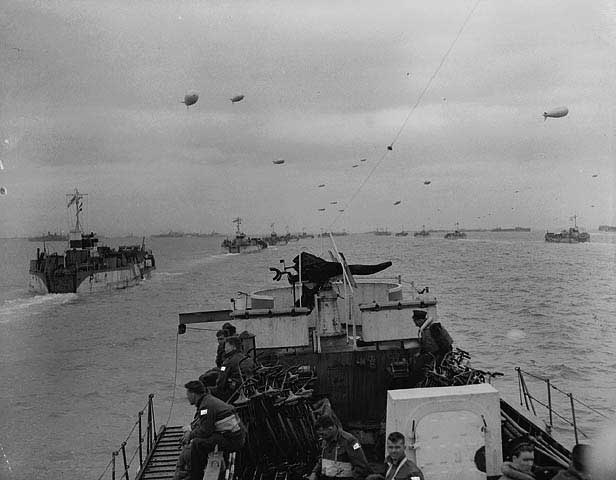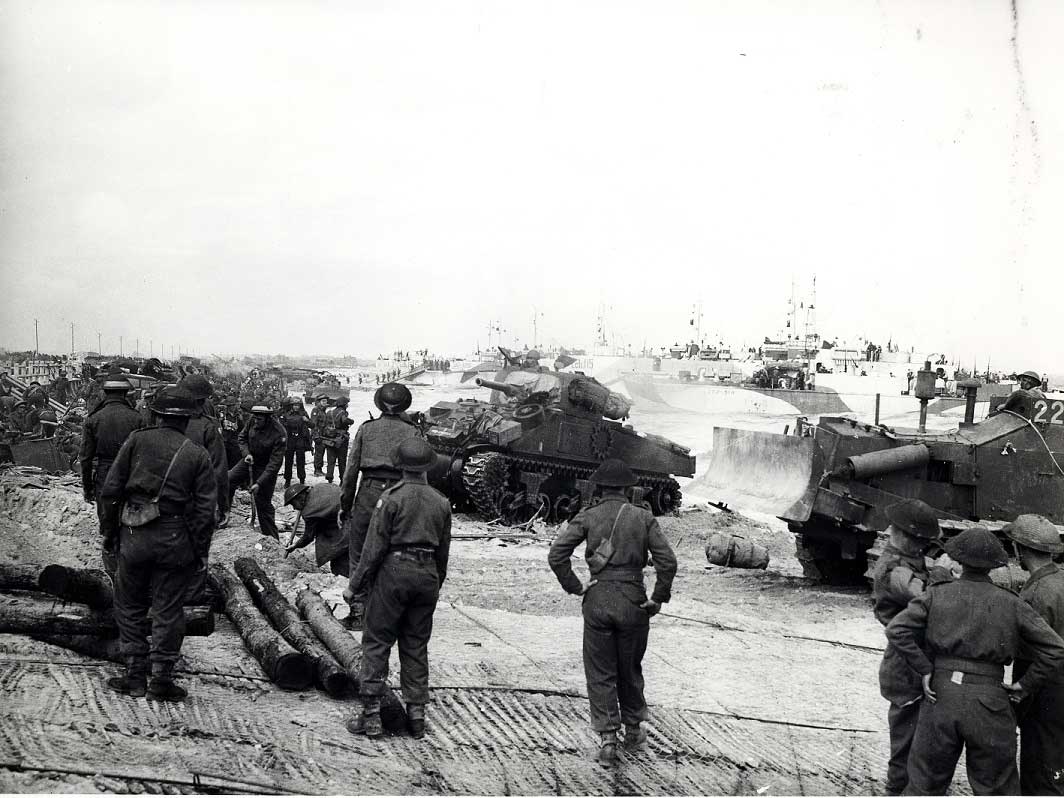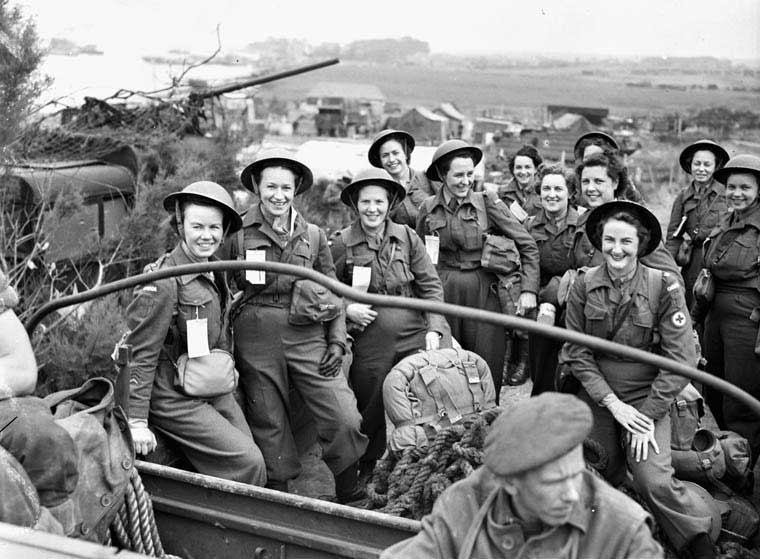Canada Remembers – D-Day and the Battle of Normandy
Canadians took part in many hard struggles to help the Allies to victory during the Second World War. D-Day and the Battle of Normandy was one of the best-known chapters of the entire conflict and our service members would play an important role in this pivotal campaign.
Setting the scene
This publication is available upon request in alternate formats.
PDF Version
Germany invaded much of Western Europe in the spring of 1940, during the opening months of the Second World War. A narrow stretch of sea, the English Channel, was all that separated the surging enemy forces from Great Britain, but the island nation held firm. The conquered countries on the continent would suffer greatly under a harsh occupation in the years that followed. An Allied raid on the French coast at Dieppe in August 1942 would result in heavy losses, especially for Canadian troops, but the Allies would slowly turn the tide against the powerful enemy war machine in North Africa, Italy, on the Eastern Front, in the skies over Europe and on the Atlantic Ocean. To win the war, however, Germany would have to be defeated on the ground in Western Europe and 1944 would be the year the Allies would finally return and powerfully strike back.
The target for the Allied landing forces would be the beaches of Normandy in France. Planning and preparation for this immense undertaking, codenamed Operation Overlord, began more than a year earlier. Land, sea and air forces trained extensively and the necessary troops, ships, tanks, supplies and other equipment were steadily amassed. Misinformation was deliberately leaked to the Germans to confuse them over where the landings would actually take place. Huge portable docking facilities, called “Mulberry harbours,” were prepared for use by Allied transport ships to unload their cargoes in France. Long flexible pipes, nicknamed “PLUTO” (pipe lines under the ocean), were designed to carry fuel under the English Channel. The Allies were ready but had to wait until the weather, tides and phase of the moon were right in order to be able to attack.
"Fortress Europe"
Successfully establishing a beachhead in occupied France would be a huge challenge for the Allied forces. The Germans had turned the coast of Europe from the Spanish border to Scandinavia into a daunting series of defensive positions. Dubbed “Fortress Europe” by Adolf Hitler, its shores were studded with land mines, barbed wire, concrete bunkers, artillery batteries, machine-gun nests, anti-tank walls, and thousands of watchful enemy troops.
An Allied defeat on the beaches of Normandy would have been disastrous as there was no way to safely evacuate troops in large numbers, so huge casualties would be inevitable. If the landings were successful, however, our forces would finally gain that all-important foothold in Western Europe and could begin the liberation campaign after years of harsh German occupation.
On land, by sea and in the air
Allied warplanes helped pave the way for the Normandy landings. They undertook countless missions attacking coastal defences and lines of transport in occupied Europe in the months leading up to Operation Overlord. Despite questionable weather conditions, the Allied high command made the decision to attack on June 6, 1944—a date that has become known in history as “D-Day.” A massive Allied force would cross the English Channel, heading for an 80-kilometre stretch of the Normandy coast. There were five landing zones assigned to the forces of different nations: Juno Beach (Canada); Gold Beach (United Kingdom); Sword Beach (United Kingdom and France); and Utah Beach and Omaha Beach (United States).
Some 7,000 naval vessels of all types, including 284 major combat ships, took part in Operation Neptune (as the sea-borne assault phase of the D-Day offensive was codenamed). Destroyers and supporting craft of the Royal Canadian Navy shelled German positions onshore and cleared sea mines in the approaches to the French beaches. Many Royal Canadian Air Force planes were among the some 4,000 Allied bombers and 3,700 fighters / fighter bombers that relentlessly struck at shoreline defences, inland targets and enemy squadrons that day.
More than 450 members of the 1st Canadian Parachute Battalion jumped inland before dawn on June 6 and were the first of our soldiers to engage the enemy on D-Day. A few hours later, some 14,000 Canadian troops from the 3rd Canadian Infantry Division and the 2nd Canadian Armoured Brigade—composed of military units from coast to coast—would begin to come ashore at Juno Beach. Their mission was to brave heavy fire to establish a foothold along an eight-kilometre stretch of coastline fronting the villages of Saint-Aubin-sur-Mer, Bernières-sur-Mer, Courseulles-sur-Mer, and Graye-sur-Mer. Our soldiers would then push inland towards the city of Caen, an important communications and transport centre.
A hard-won victory
Many Canadian soldiers were young and new to battle, but our infantry and armoured troops would be thrown into action against some of the best of the German forces in Normandy. The Canadians successfully captured their shoreline positions at Juno Beach and penetrated the farthest inland of any of the some 155,000 Allied troops who had landed on June 6, 1944, but D-Day was only the beginning of the struggle to liberate France. Clashes in the days that followed badly bloodied our soldiers and they repeatedly found themselves pitted against the elite 12th SS Panzer Division, manned by fanatical troops under the command of ruthless and experienced German officers. The first month of fighting was an exercise in grim endurance for the Canadians as the combat intensified and capturing Caen remained elusive.
The Canadians would bend but not break; however, the memory of the bitter fighting they encountered in villages like Authie, Buron and Carpiquet would haunt our Veterans for years to come. Our navy and air force continued to support the campaign as they kept the sea lanes clear of enemy shipping and swept German warplanes from the skies over Normandy, while also pounding countless ground targets. Caen finally fell to British and Canadian troops on July 9–10, but the fighting would continue through the choking dust and intense summertime heat in the countryside south of the city. Canadian troops battled forward despite desperate struggles at places like Verrières Ridge, which our soldiers helped capture only after multiple bloody attempts had cost many hundreds of lives, with even more being wounded.
With an American breakout against weakening German troops in western Normandy coming in early August, the stiff enemy defenses in France finally began to collapse. As the German forces began to stream eastward away from the surging Allied lines, Canadian troops would be called on to help close the so-called “Falaise Gap” in mid-August to trap the retreating enemy units. It would take repeated efforts on a chaotic battlefield, but the pocket would finally be completely cut off by August 21, resulting in the taking of tens of thousands of desperate German prisoners. On August 25, 1944, Paris was liberated by the Allies, officially bringing the Normandy campaign to a close.
Sacrifice
Victory in the Battle of Normandy came at a terrible cost. The Canadians suffered the highest casualties of any divisions in the British Army Group during the campaign. Some 359 Canadian soldiers were killed on D-Day alone, and a total of more than 5,000 of our men would die during the two-and-a-half-months of fighting in Normandy. Most of these fallen heroes lie buried in France in the beautiful Bény-sur-Mer Canadian War Cemetery and the Bretteville-sur-Laize Canadian War Cemetery. Over 13,000 more of our soldiers were wounded in Normandy, with many suffering injuries to body and mind that they would carry for the rest of their lives.
Legacy
Normandy was the beginning of 11 months of hard fighting in Northwest Europe. Canadians would also go on to play an important role in bitter struggles at places like the Scheldt, the Rhineland and the Netherlands during the Allied offensives that would eventually help defeat the Germans and see Victory in Europe (V-E) Day declared on May 8, 1945.
Canada’s impressive efforts in the Second World War remain a point of great national pride, even many decades later. The brave Canadians who came ashore on D-Day and saw action in the Battle of Normandy were among the more than one million men and women from our country who served in the cause of peace and freedom during the conflict. Sadly, over 45,000 of them would lose their lives.
Canada Remembers Program
The Canada Remembers Program of Veterans Affairs Canada encourages all Canadians to learn about the sacrifices and achievements made by those who have served—and continue to serve—during times of war and peace. As well, it invites Canadians to become involved in remembrance activities that will help preserve their legacy for future generations.
- Date modified:


